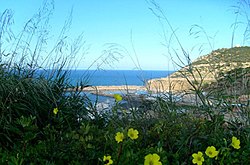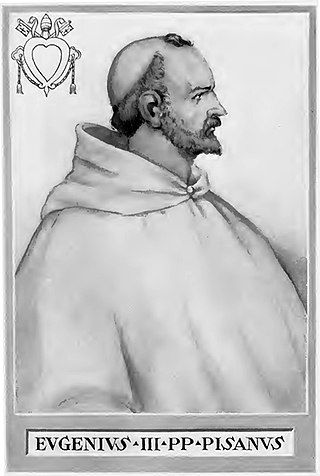
Year 1145 (MCXLV) was a common year starting on Monday of the Julian calendar.

The Almohad Caliphate was a North African Berber Muslim empire founded in the 12th century. At its height, it controlled much of the Iberian Peninsula and North Africa.

Medieval Muslim Algeria was a period of Muslim dominance in Algeria during the Middle Ages, spanning the millennium from the 7th century to the 17th century. The new faith, in its various forms, would penetrate nearly all segments of society, bringing with it armies, learned men, and fervent mystics; in large part, it would replace tribal practices and loyalties with new social norms and political idioms.

Tlemcen is the second-largest city in northwestern Algeria after Oran, and capital of the Tlemcen Province. The city has developed leather, carpet, and textile industries, which it exports through the port of Rachgoun. It had a population of 140,158 at the 2008 census, while the province had 949,135 inhabitants.

The Hammadid dynasty was a branch of the Sanhaja Berber dynasty that ruled an area roughly corresponding to north-eastern modern Algeria between 1008 and 1152. The state reached its peak under Nasir ibn Alnas during which it was briefly the most important state in Northwest Africa. Its realm was conquered by the Almohad Caliphate.
The Zayyanid dynasty or Abd al-Wadids was a Berber Zenata dynasty that ruled the Kingdom of Tlemcen, mainly in modern Algeria centered on the town of Tlemcen in northwest Algeria. The Zayyanid dynasty's rule lasted from 1235 to 1557
The Zenata are a group of Amazigh (Berber) tribes, historically one of the largest Berber confederations along with the Sanhaja and Masmuda. Their lifestyle was either nomadic or semi-nomadic.

The Marinid Sultanate was a Berber Muslim empire from the mid-13th to the 15th century which controlled present-day Morocco and, intermittently, other parts of North Africa and of the southern Iberian Peninsula (Spain) around Gibraltar. It was named after the Banu Marin, a Zenata Berber tribe. The sultanate was ruled by the Marinid dynasty, founded by Abd al-Haqq I.

Abū Yūsuf Yaʿqūb ibn Yūsuf ibn Abd al-Muʾmin al-Manṣūr, commonly known as Yaqub al-Mansur or Moulay Yacoub, was the third Almohad Caliph. Succeeding his father, al-Mansur reigned from 1184 to 1199. His reign was distinguished by the flourishing of trade, architecture, philosophy and the sciences, as well as by victorious military campaigns in which he was successful in repelling the tide of the Reconquista in the Iberian Peninsula.
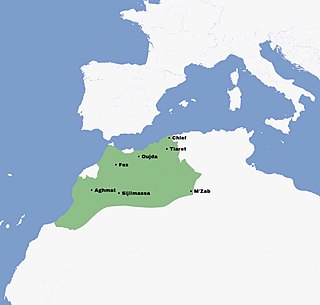
The Maghrawa or Meghrawa were a large Zenata Berber tribal confederation whose cradle and seat of power was the territory located on the Chlef in the north-western part of today's Algeria, bounded by the Ouarsenis to the south, the Mediterranean Sea to the north and Tlemcen to the west. They ruled these areas on behalf of the Umayyad Caliphate of Cordoba at the end of the 10th century and during the first half of the 11th century.
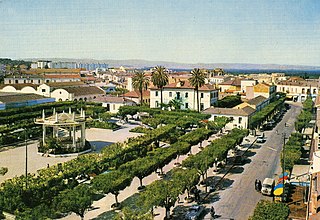
Relizane or Ghilizan is a city in Algeria. It is the capital city of Relizane Province.
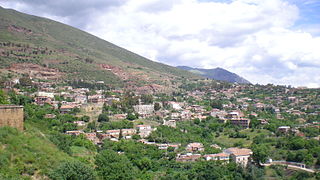
Miliana is a commune in Aïn Defla Province in northwestern Algeria. It is the administrative center of the daïra, or district, of the same name. It is approximately 114 kilometres (71 mi) southwest of the Algerian capital, Algiers. The population was estimated at 44,201 in 2008. The town is located south of the Dahra Range, on the wooded southern flank of Mount Zaccar Rherbi, five kilometers north of the Chelif River, and overlooking the Zaccar plateau to the west.
Abu Muhammad Abd al-Haqq I was the first leader of the Marinid dynasty of the Maghreb.

Beni Snous or Aït Snous is a town and commune in Tlemcen Province in northwestern Algeria.

Yaghmurasen Ibn Zyan was the founder of the Zayyanid dynasty. Under his reign the Zayyanid Kingdom of Tlemcen extended over present-day north-western Algeria.

Abu-l-Hasan Ali ibn Ruburtayr or Reverter was the younger son of Reverter I viscount of Barcelona, and a Muslim Catalan mercenary commander. He left the Christian faith and territories, and converted to Islam. His Christian name is unknown.

The Kingdom of Tlemcen or Zayyanid Kingdom of Tlemcen was a Berber kingdom in what is now the northwest of Algeria. Its territory stretched from Tlemcen to the Chelif bend and Algiers, and at its zenith reached Sijilmasa and the Moulouya River in the west, Tuat to the south and the Soummam in the east.
Alfred Bel was a French orientalist and scholar of Arab culture. He was the director of the Médersa de Tlemcen from 1905 to 1935.

The Sulaymanid dynasty was an Arab Muslim dynasty in present-day western Algeria, ruling from 814 to 922. The dynasty is named after the founder, Sulyaman I, who was the brother of Idris I, the founder of the Idrisid dynasty based in Fez. Both Sulayman and Idris, as great grandchildren of Hasan ibn Ali, were sharifs descended from Muhammad.
Zaynab bent Youssef Ibn ‘Abd al-Moumen was an Almohad princess who took part at conferences on the sources of the law, she went down in history as a learned woman. She was the daughter of Almohad caliph Abu Yaqub Yusuf.
